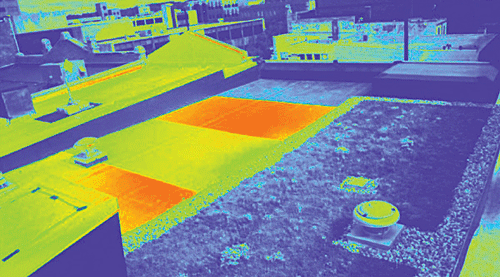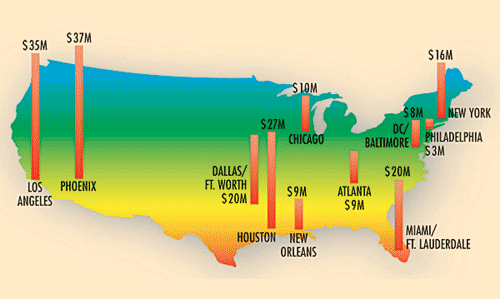What's So Cool About Cool Roofs?
AIR QUALITY AND CLIMATE CHANGE: HOW COOL ROOFS HELP
Through mitigation of the urban heat island effect with the reduction of ambient air temperatures, cool roofs also improve air quality. Smog is created by photochemical reactions of air pollutants, and these reactions increase at higher temperatures. In Los Angeles alone, mitigation measures that reduce the average air temperature by 3K (5 °F) could yield a 12 percent reduction in smog (ozone) worth $360 M/year.i Lower ambient air temperatures and the subsequent improved air quality also result in a reduction in heat-related and smog-related health issues, including heat stroke and asthma. In addition to the reduction of greenhouse gas emissions such as CO2, by conserving electricity for air conditioning cool roofs reduce the emission of NO2 and SO2 particulates from power plants.
 |
This thermal image illustrates the reflected solar radiation from three different cool roof surfaces on an Ann Arbor, MI rooftop. The two roof segments that appear bright orange correspond to the two most reflective products and the bright yellow segments to the somewhat less reflective product. The dark purple areas indicate the non-cool portions of the roof (or the least reflective surfaces). The original photo is found on page 6. Photo courtesy of A3C Architectural Collaborative |
Â
A Lawrence Berkeley National Laboratory study found that world-wide reflective roofing will produce a global cooling effect equivalent to offsetting 24 gigatons of CO2 over the lifetime of the roofs. This equates to $600 billion in energy savings.ii The study recommends cool roofs as a geo-engineering mechanism to counteract climate change.
CALCULATING ENERGY SAVINGS
 |
Nationwide implementation of cool roofs could mean an annual savings of Image courtesy of Lawrence Berkeley National Laboratory |
Â
Research by the Heat Island Group found that buildings with lightly colored, more reflective roofs use up to 40 percent less energy for cooling than buildings with darker roofs.iii To calculate the possible savings in energy provided by a cool roof, there are two online roof calculators that estimate savings.
The DOE Cool Roof Calculator was developed by the U.S. Department of Energy's Oak Ridge Laboratory. This calculator provides an estimate of cooling and heating savings for small to medium size facilities that purchase electricity with a demand charge and an alternative versionfor larger facilities. http://www.ornl.gov/sci/roofs%2Bwalls/facts/CoolCalcEnergy.htm
The EPA Cool Roof Calculator is provided by ENERGY STAR. This calculator allows the designer to input specific details about a building, including heating and cooling systems as well as location and the cost of energy. http://www.roofcalc.com/RoofCalcBuildingInput.aspx
These calculators provide a simple pay back analysis to determine the savings in electricity or natural gas through the installation of a cool roof.
The Southwest Energy
Efficiency Project (SWEEP) |
|
|









